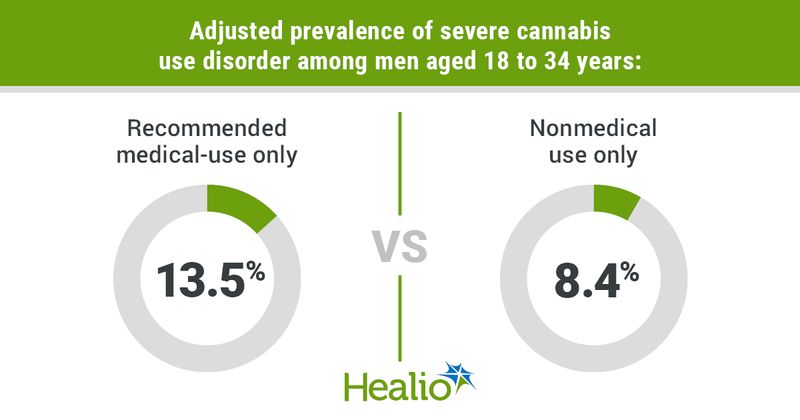Medical cannabis use still linked to addiction
Key takeaways:
- Approximately one-third of the cohort who reported using cannabis in the past year had cannabis use disorder.
- Cannabis use disorder was significantly more common among medical users than recreational users.
Adults aged 18 to 49 years who used cannabis for medical reasons had higher rates of cannabis use disorder compared with adults who only used cannabis recreationally, according to a research letter published in JAMA Psychiatry.
As more individuals use cannabis for medical purposes, “patients and clinicians need to be aware of its potential risks,” Beth Han, MD, PhD, MPH, epidemiologist at the NIH National Institute on Drug Abuse, and colleagues wrote.

Frequent use and cannabis use disorder (CUD) — which are linked to an increased risk for negative health, academic and social outcomes — may become concerns when individuals use medical cannabis daily to manage their conditions, they added.
To examine differences in cannabis use frequency and CUD prevalence based on type of use, the researchers performed a retrospective cross-sectional study that included data from 72,668 adults aged 18 to 49 years (the most common cannabis users by age) who participated in the 2021 to 2022 National Surveys on Drug Use and Health (NSDUH). The researchers defined categories of use as:
- Medical: entirely recommended by health care professionals (9.2%; 95% CI, 8.5-10);
- Medical-nonmedical: some medical use based on doctor recommendations and some recreational use (5.7%; 95% CI, 5.2-6.2); or
- Nonmedical: entirely recreational use (83.7%; 95% CI, 82.8-84.6).
The researchers used DSM-5 criteria to define CUD severity as mild (2-3 symptoms), moderate (4-5 symptoms) or severe ( 6 symptoms).
Overall, the researchers found that among the total population, 29.5% (95% CI, 28.6-30.3) reported using cannabis in the past year. They also found that 34.8% (95% CI, 33.6- 36) of the cohort had CUD.
Among those aged 18 to 34 years, adults who reported medical-only cannabis use had higher adjusted rates of severe (women, 7.4% vs. 6%; men, 13.5% vs. 8.4%), moderate (women, 11.6% vs. 9.9%; men, 16.9% vs. 12.3%) and mild (women, 19.8% vs. 18.1%; men, 22.5% vs. 19.6%) CUD compared their counterparts who reported nonmedical use.
A similar trend occurred for men aged 35 to 49 years who reported medical-only cannabis use.
Finally, the researchers found that after adjustments, adults who reported medical or medical-nonmedical use of cannabis had more days of use on average over the past year than adults who only used cannabis recreationally. For example, men aged 18 to 34 years with medical-only use had 217.2 (95% CI, 193.8-243.4) days of use, whereas men with nonmedical use had only 154.3 (95% CI, 147.8-161.1) days of use.
The researchers noted several limitations to this study, including that NSDUH is a self-reported survey and that diagnostic criteria for CUD were developed before the recent spike in cannabis use.
“These findings suggest that medically recommended cannabis is not associated with reduced addiction risk compared with nonmedical use,” Han and colleagues wrote.
“Clinicians should consider addiction risk before recommending medical cannabis and, if they do, should monitor for CUD emergence,” they added.


